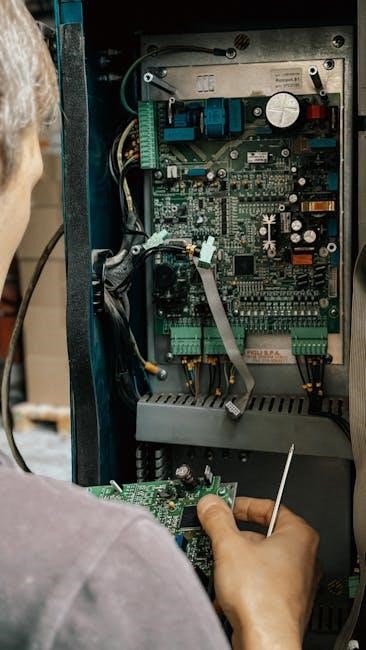
The Behringer X Air XR18 is a high-performance digital mixer designed for live and studio applications, offering 18 inputs, 12 buses, and wireless control via iOS and Android devices.
1.1 Overview of the XR18 Mixer
The Behringer X Air XR18 is a compact, 18-input digital mixer designed for live sound and studio applications. It features 16 MIDAS preamps, 8 XLR outputs, and wireless control via iOS and Android devices. The mixer supports up to 12 buses and offers high-quality audio processing with intuitive control through the X Air app. Its sturdy stage box design makes it ideal for portable use, while the integrated Wi-Fi module ensures seamless connectivity. The XR18 is part of Behringer’s X Air series, known for its versatility and professional-grade performance. Users can access detailed operation guides and manuals online for optimal setup and troubleshooting.
1.2 History and Development of the XR18
The Behringer X Air XR18 was developed as part of Behringer’s commitment to innovation in live sound technology. Released as an advancement in the X Air series, the XR18 combines MIDAS preamps with digital mixing capabilities, offering a powerful yet portable solution. Designed to meet the demands of both live performances and studio recordings, the XR18 features wireless control via tablets, enhancing flexibility for engineers. Its development focused on integrating high-quality components with user-friendly software, ensuring professional-grade performance. Regular firmware updates and user feedback have further refined the mixer, making it a trusted tool in the audio industry.

Key Features and Specifications
The Behringer X Air XR18 offers 18 inputs, 12 buses, 16 MIDAS preamps, 8 XLR outputs, integrated Wi-Fi, and USB interface, ensuring high-quality audio processing and versatility.
2.1 Inputs and Outputs Configuration
The Behringer X Air XR18 is equipped with 18 inputs, including 16 high-quality MIDAS microphone preamps, and 8 XLR outputs for flexible connectivity. The inputs are divided into 16 mono channels and 1 stereo channel, providing ample options for connecting microphones, instruments, and other audio sources. Additionally, the mixer features a USB interface for recording and playback, as well as a headphone output for monitoring. The outputs are fully assignable, allowing for customizable routing to main speakers, monitor mixes, or external effects processors. This configuration ensures versatility for both live performances and studio environments, catering to a wide range of audio needs.
2.2 MIDAS Preamps and Audio Quality
The Behringer X Air XR18 features 16 award-winning MIDAS preamps, renowned for their pristine audio quality and high headroom. These preamps deliver exceptional clarity and transparency, capturing every nuance of your audio sources with precision. The MIDAS preamps are designed to handle both dynamic and condenser microphones effortlessly, providing a clean and uncolored sound. With a focus on reducing noise and distortion, the XR18 ensures that your audio remains crisp and professional. The mixer’s digital signal processing further enhances the audio quality, offering a wide range of options for EQ, compression, and effects. This combination of high-quality preamps and advanced processing makes the XR18 a standout choice for achieving studio-grade sound in live and studio environments.

Setup and Installation Guide
Unbox and inspect the XR18, ensuring all components are included. Connect the mixer to a power source and link your devices via USB or wireless connectivity for seamless operation.
3.1 Unboxing and Initial Inspection
When unboxing the Behringer X Air XR18, carefully inspect the mixer and its components. Ensure all items, such as the power cable, USB cable, and Quick Start Guide, are included. Check the mixer’s exterior for any visible damage or defects. Familiarize yourself with the layout, including the MIDAS preamps, LCD screen, and input/output sections. Verify that all buttons, faders, and connectors are functioning properly. Before powering on, ensure the mixer is placed on a stable, flat surface. Review the manual for initial setup instructions to avoid damaging the device. Proper inspection ensures a smooth setup and optimal performance.
3.2 Connecting and Powering Up the Mixer
Before powering up the Behringer X Air XR18, ensure all connections are secure. Plug in the power cable into a reliable source and connect your devices to the designated inputs. Use XLR cables for microphones and 1/4-inch cables for line-level sources. Avoid overloading inputs to prevent damage. Once all connections are made, press the power button. The mixer will boot up, and the LCD screen will display the startup sequence. Allow a few seconds for initialization. Check that all LED indicators function properly and confirm that the mixer is operational. If using wireless control, ensure your tablet or smartphone is connected to the mixer’s Wi-Fi network. Refer to the manual for detailed connection diagrams and troubleshooting tips if issues arise.
Navigating the XR18 Mixer
The Behringer X Air XR18 features a user-friendly interface with a high-resolution touchscreen, allowing easy access to mixing functions. The home screen provides quick navigation to channels, effects, and routing. Customizable fader layouts and intuitive controls streamline the mixing process. The X Air app enables wireless control, simplifying real-time adjustments during performances.
4.1 User Interface Overview
The Behringer X Air XR18 mixer features a sleek and intuitive user interface designed for efficient navigation. The high-resolution touchscreen display provides clear access to all mixing functions, while customizable fader layouts allow for personalized workflow. The home screen offers quick access to essential controls, including channel levels, effects, and routing options. Metering and visualization tools are prominently displayed, enabling precise monitoring of audio levels and signal flow. Logical grouping of controls ensures that users can quickly locate and adjust parameters, making the mixing process seamless. This design emphasizes usability, catering to both novice and experienced engineers. The interface is complemented by wireless control via the X Air app, enhancing flexibility during live performances or studio sessions.
4.2 Basic Mixing Operations
Basic mixing operations on the Behringer X Air XR18 begin with configuring input channels and setting levels. Users can adjust fader positions to control volume, utilize the one-knob compressors for dynamics, and apply 4-band parametric EQ for tone shaping. The mixer supports DCA groups for managing multiple channels simultaneously, while mute and solo functions aid in isolating or focusing on specific tracks. Effects like reverb and delay can be assigned to channels or auxiliary sends for enhancing the mix. Scene management allows saving and recalling custom configurations, streamlining workflow during live performances or studio sessions. The XR18’s intuitive design ensures that even complex mixing tasks remain accessible, making it suitable for engineers of all experience levels.
Connectivity and Wireless Control
The Behringer X Air XR18 features built-in Wi-Fi for wireless control via iOS and Android devices, enabling remote mixing and effects adjustments. USB connectivity supports multi-channel audio interfaces.
5.1 Setting Up Wireless Connectivity
To set up wireless connectivity for the Behringer X Air XR18, ensure both the mixer and your tablet are on the same network. Download the X Air app from the app store and connect your tablet to the mixer’s built-in Wi-Fi network, which should appear in your available networks. Enter the default password provided in the manual or set up a new one for security. Open the X Air app to access the mixer’s interface, which mirrors the mixer’s controls. Adjust any necessary settings within the app for network configuration or device pairing. Check the mixer’s menu for Wi-Fi settings and ensure a stable connection for reliable performance. Test the connection beforehand to avoid interference and ensure your tablet is fully charged. Refer to the manual for additional guidance and troubleshooting tips.
5.2 Using the X Air App for Remote Control
The X Air app allows seamless remote control of the Behringer XR18 mixer via iOS or Android devices. Download the app from the App Store or Google Play and ensure your tablet is connected to the mixer’s Wi-Fi network. Once connected, the app mirrors the mixer’s interface, enabling control of faders, mutes, and effects. Users can adjust levels, pan settings, and EQ parameters in real-time. The app also supports custom fader layers and scenes for efficient workflow. For advanced control, access the app’s routing and effects sections to fine-tune your mix. Regularly update the app to access new features and improvements. Refer to the manual for detailed instructions on optimizing the app’s performance and troubleshooting connectivity issues.

Advanced Mixing Features
The XR18 offers advanced mixing tools, including effects processing, customizable signal routing, and automation, enabling precise control over your audio for professional-grade results.
6.1 Effects Processing and Options
The Behringer X Air XR18 offers a robust effects processing suite, including high-quality reverb, delay, chorus, and compressor options. These effects are customizable and can be applied to individual channels or master outputs, providing versatile sound-shaping capabilities. The mixer also supports external effects integration, allowing users to expand their creative possibilities. With a user-friendly interface, the XR18 enables seamless navigation through effects libraries and real-time adjustments. This feature-rich processing ensures professional-grade audio enhancement, making it ideal for live performances and studio recordings. The effects section is complemented by intuitive controls, allowing for precise tweaking to achieve the desired sound.
6.2 Customizable Signal Routing
The Behringer X Air XR18 offers highly customizable signal routing options, allowing users to tailor their audio configuration to meet specific needs. With 18 inputs and 12 buses, the mixer provides flexibility in routing signals to main outputs, subgroups, or auxiliary sends. Users can easily assign channels to different buses and customize the signal flow for complex mixing scenarios. The XR18 also supports custom routing configurations via the X Air app, enabling wireless adjustments for seamless integration into live and studio setups. This feature ensures that audio signals can be directed precisely where needed, enhancing workflow efficiency and creative control for engineers and performers alike.

Troubleshooting Common Issues
Troubleshooting the Behringer X Air XR18 involves checking connections, restarting devices, and updating firmware. Consult the manual for solutions to common issues like audio dropouts or connectivity problems.
7.1 Updating Firmware and Software
Regular firmware and software updates are essential for optimal performance of the Behringer X Air XR18. To update, download the latest firmware from the Music Tribe website and use the X AIR EDIT software to upload it to the mixer. Ensure the device is connected via USB or wirelessly and follow the manual’s step-by-step guide. Updates often include bug fixes, feature enhancements, and compatibility improvements. Always back up settings before updating to avoid data loss. Refer to the official manual or online support for detailed instructions. Regular updates ensure your XR18 stays current with the latest features and functionalities, maintaining its performance and reliability.
7.2 Resolving Common Technical Issues
Common issues with the Behringer X Air XR18 can often be resolved through troubleshooting steps. Connectivity problems may require restarting the mixer or updating the X Air app. Audio dropouts could indicate improper gain staging or outdated firmware. Check the manual for detailed solutions, such as resetting to factory settings or verifying network configurations. For persistent issues, consult the official support page or contact Behringer directly. Regular maintenance, like cleaning inputs and ensuring stable power, can prevent many technical problems. Always refer to the user manual or online resources for specific guidance tailored to your situation.

Maintenance and Care Tips
Regularly clean the XR18 with a soft cloth and compressed air to prevent dust buildup. Check all connections and cables for damage. Store in a protective case when not in use to avoid physical damage. Ensure software is always up-to-date for optimal performance.
8.1 Cleaning and Physical Maintenance
Regular cleaning is essential to maintain the XR18’s performance and longevity. Use a soft, dry cloth to wipe down the exterior and controls, avoiding harsh chemicals or liquids. For stubborn stains, a slightly damp cloth can be used, but ensure no moisture enters the device. Inspect all cable connectors and inputs regularly for dust or debris, using compressed air to clean them gently. Avoid exposing the mixer to extreme temperatures or humidity. Store the XR18 in a protective case when not in use to prevent physical damage. Proper maintenance ensures optimal functionality and preserves the mixer’s high-quality audio performance.
8.2 Keeping Software Up-to-Date
Regular software updates are crucial for optimal performance and security of the Behringer X Air XR18. Download the latest firmware from the Music Tribe website and follow the instructions provided in the update guide. Use the X AIR EDIT software to connect to the mixer and apply updates seamlessly. Ensure your device is fully powered during the update process to avoid interruptions. Behringer frequently releases updates to enhance features, fix bugs, and improve compatibility. Always refer to the official manual or support resources for detailed guidance on updating your XR18. Staying current with software ensures you have access to the latest features and maintain the mixer’s peak performance.

Accessories and Expansion Options
Enhance your XR18 experience with official Behringer accessories, including protective cases, network adapters, and expansion modules. These additions ensure optimal performance and durability for professional use.
9.1 Recommended Accessories for XR18
To maximize the functionality and longevity of your Behringer X Air XR18, consider investing in recommended accessories. A protective carrying case ensures safe transportation, while a network adapter enhances wireless connectivity. Additionally, expansion modules can add more inputs or outputs, tailoring the mixer to your needs. A high-quality USB interface or MIDI controller can also streamline your workflow. For live performances, a sturdy stage box or rackmount kit is essential for secure installation. Always opt for Behringer-approved accessories to maintain compatibility and performance. These additions not only enhance convenience but also protect your investment, ensuring the XR18 remains a reliable tool for years to come.
9.2 Expanding Functionality with Add-Ons
Expanding the functionality of your Behringer X Air XR18 can be achieved through various add-ons tailored to enhance its capabilities. Additional effects processors or DSP modules can add depth to your audio processing, while network expansion cards offer improved connectivity options. Custom control surfaces or MIDI controllers provide enhanced hands-on control, allowing for more intuitive operation during live performances or studio sessions. Furthermore, compatible Behringer stage boxes and expansion stages can increase input and output options, making the XR18 adaptable to larger setups. These add-ons ensure that your mixer evolves with your needs, providing flexibility and scalability for both professional and personal use.

Comparing with Other Behringer Models
The Behringer X Air XR18 stands out among its siblings like the XR16 and X18, offering 18 channels, MIDAS preamps, and advanced wireless control for live sound applications.
10.1 XR18 vs. XR16: Key Differences
The Behringer X Air XR18 and XR16 are both digital mixers designed for live sound, but they differ in channel count and connectivity options. The XR18 offers 18 channels, while the XR16 provides 16 channels, making the XR18 suitable for larger setups. Both models feature MIDAS preamps and wireless control via tablets, ensuring high-quality audio processing. However, the XR18 includes an additional USB interface for direct computer connectivity, enhancing its versatility for recording and live applications. Despite these differences, both mixers share the same intuitive user interface and robust build quality, making them popular choices among sound engineers and musicians alike.
10.2 XR18 vs. X18: Feature Comparison
The Behringer X Air XR18 and X18 are both digital mixers but cater to different user needs. The XR18 is designed as a stage box mixer, ideal for live performances with its rugged build and direct connectivity options. In contrast, the X18 is more compact and portable, making it suitable for smaller setups and personal use. Both models feature 18 channels, MIDAS preamps, and wireless control via tablets. However, the XR18 includes additional features like a built-in Wi-Fi module and multi-channel USB audio interface, enhancing its functionality for professional applications. While the X18 is more affordable and lightweight, the XR18 offers advanced connectivity and durability, making it a preferred choice for professional sound engineers and bands.

User Reviews and Feedback
Users praise the XR18 for its MIDAS preamps, wireless control, and sturdy build. Some note a steep learning curve, but overall, it’s highly rated for its professional features and reliability.
11.1 Positive User Experiences
The Behringer X Air XR18 has received widespread acclaim for its versatility and performance. Many users highlight its ease of use, with the intuitive X Air app enabling seamless wireless control via tablets. The mixer’s compact design and robust build quality make it ideal for both live and studio settings.
Professionals praise the XR18’s high-quality MIDAS preamps, which deliver crystal-clear audio reproduction. The integrated Wi-Fi module and multi-channel USB interface further enhance its functionality, allowing for efficient multitrack recording and playback. Overall, the XR18 is celebrated as a powerful yet affordable solution for modern audio production needs.
11.2 Common Criticisms and Feedback
Despite its popularity, the Behringer X Air XR18 has faced some criticism. Some users have noted occasional connectivity issues with the Wi-Fi module, particularly in environments with high interference. Additionally, the lack of physical faders has been a point of contention for those accustomed to traditional mixing consoles.
A few users have also reported firmware update challenges, which can be frustrating for less tech-savvy individuals. However, Behringer has been responsive to these issues, releasing regular updates to improve stability and functionality. Overall, while the XR18 excels in many areas, these minor drawbacks highlight opportunities for refinement in future iterations.

Resources and Support
Behringer provides comprehensive support resources, including downloadable PDF manuals, firmware updates, and dedicated customer service for troubleshooting and technical assistance.
12.1 Downloading the Official Manual
To access the Behringer X Air XR18 manual, visit the official Behringer website. Navigate to the product page for the XR18 and locate the “Downloads” or “Support” section. Here, you can download the official PDF manual, which includes detailed instructions for setup, operation, and troubleshooting. The manual is free and available in multiple languages. Ensure you download the correct version for your firmware. For additional convenience, the manual can be saved to your device for offline use. This comprehensive guide provides in-depth insights into the mixer’s features and functionality, making it an essential resource for both new and experienced users.
12.2 Contacting Behringer Support
To contact Behringer Support, visit their official website at https://www.behringer.com/support/. Here, you can submit a support ticket by filling out the contact form, which requires basic information like your name, email, and details about your inquiry. Additionally, you can reach out via email or phone for direct assistance. For XR18-related issues, ensure to include your product serial number for faster resolution. Before contacting support, it’s recommended to consult the official manual or FAQs, as many common questions are already addressed. Registered users can also access exclusive support resources by logging into their account on the Behringer website. Behringer’s support team is available to assist with troubleshooting, firmware updates, and technical queries.